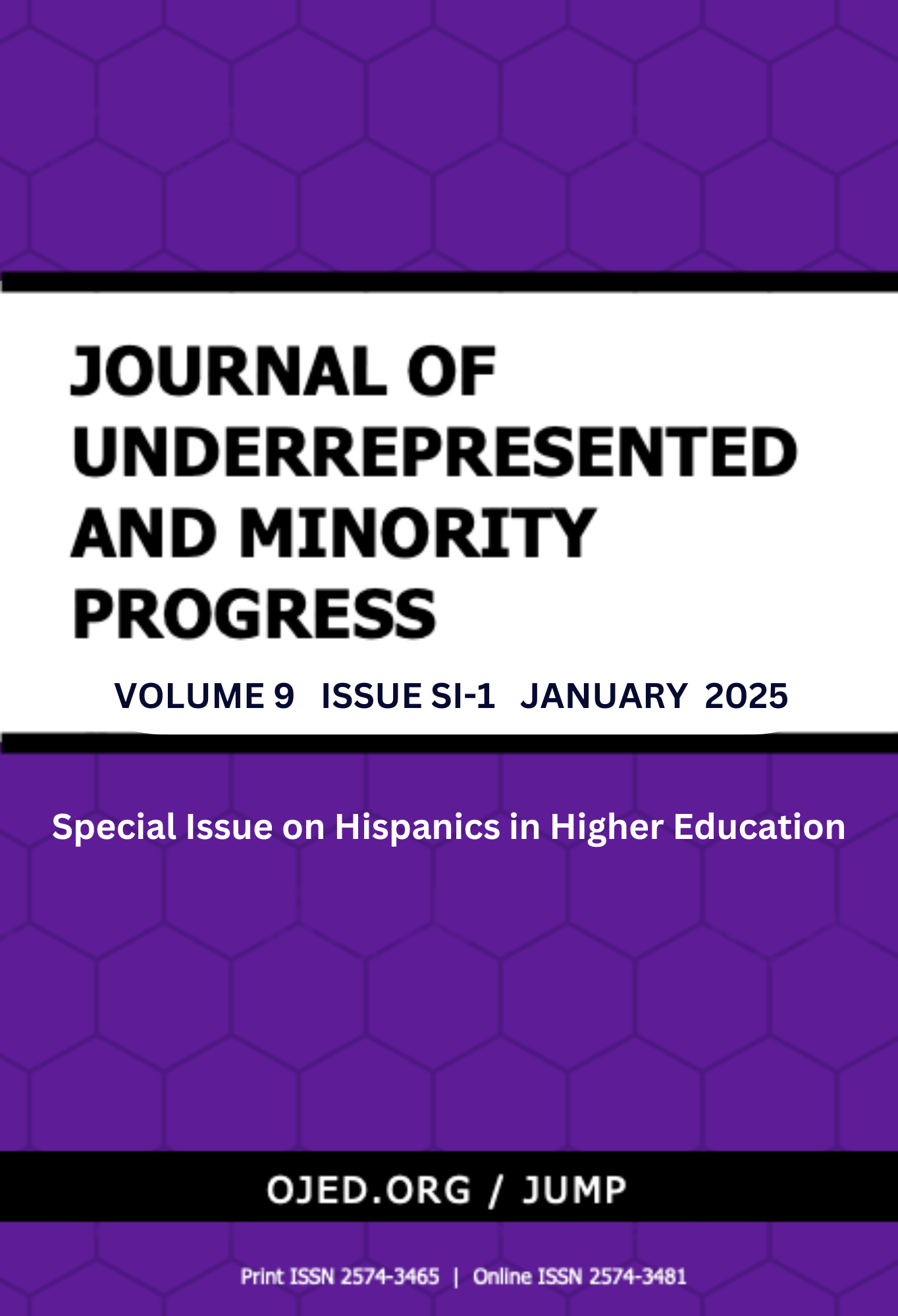Garbanzos de a libra: The Community Cultural Wealth of Male Bilingual Teachers
DOI:
https://doi.org/10.32674/sr6xe694Keywords:
male bilingual teachers, teacher preparation, higher educationAbstract
Latino males are “effectively vanishing” (Saenz & Ponjuan, 2009, p. 54) from the United States higher education pipeline, a phenomenon clearly evident in the K-12 and postsecondary levels; they have become an ultra-minoritized population. Saenz and Ponjuan (2009) expound various theoretical and socio-cultural explanations for this enduring and distressing trend facing Latino males. In particular, the lack of male teachers as young Latino boys traverse their compulsory education is problematic as representation is critical for persistence and mentoring. As the number of Emergent Bilingual students is now 10% of the U.S. student population, the need for increasing bilingual male teachers is more important than ever. Increasing the representation of Latino male bilingual teachers in primary grade levels, can help ameliorate the leaks that Latino boys, particularly Emergent Bilinguals, encounter in the educational pipeline. Utilizing a narrative inquiry approach this study focused on the experiences of six Latino male bilingual elementary education teachers in the Southwest United States.
References
Anderson, A., & Aronson, B. (2019). Teacher Education, diversity, and the interest convergence conundrum: How the demographic divide shapes teacher education. In K.T. Han & J. Laughter (Eds.), Critical race theory in teacher education: Informing classroom culture and practice, (pp. 26-35) Teachers College Press.
Czarniawska, B. (2004). Narratives in social science research. Thousand Oaks, CA: Sage. Creswell, J. W. (2014). Research Design: Qualitative, Quantitative and Mixed Methods Approaches (4th ed.). Thousand Oaks, CA: Sage.
Chase, S. (2005). Diaz, C.(2021). I am going to show them I can do this.. Con más ganas! In Martinez, M. & Méndez-Morse. Latinas Leading Schools. Information Age Publishing, Inc.
Creswell, J. (2007). Qualitative inquiry and research design: Choosing among five approaches (2nd ed.). Thousand Oas, CA: Sage.
De Brey, C., Musu, L., McFarland, J., Wilkinson-Flicker, S., Diliberti, M., Zhang, A., ... & Wang, X. (2019). Status and Trends in the Education of Racial and Ethnic Groups 2018. NCES 2019-038. National Center for Education Statistics.
Gomez, M. L., Rodriguez, T. L., & Agosto, V. (2008). Who are Latino prospective teachers and what do they bring to US schools?. Race Ethnicity and Education, 11(3), 267-283.
Graham, D. L., Alvarez, A. J., Heck, D. I., Rand, J. K. & Milner, H. R. (2019). Race, violence, and teacher education: An overview of critical race theory in teacher education. In K.T. Han & J. Laughter (Eds.), Critical race theory in teacher education: Informing classroom culture and practice, (pp. 13-25) Teachers College Press.
Kennedy, B. (2020). The bilingual teacher shortage in one Texas school district: Practitioner perspectives. Journal of Latinos and Education, 19(4), 338-354.
Lara, G. P., & Leija, M. G. (2014). Discussing gender equality through critical encounters in children’s literature. Social Studies and the Young Learner, 27(2), 22-25.
Lara, G. P., & Fránquiz, M. E. (2015). Latino bilingual teachers: Negotiating the figured world of masculinity. Bilingual Research Journal, 38(2), 207-227.
Lara, G. (2022). Testimonios of Latino Male Preservice Teachers as Models for Caring and Bilingualism. AMAE Journal, 16(1).
Lincoln, Y. S. , & Guba, E. G. (1985). Naturalistic inquiry. Beverly Hills, CA: Sage. Lincoln, Y. S., & Guba, E. G. (2000). Paradigmatic controversies, contradictions, and emerging confluences. In Norman K. Denzin & Yvonna S. Lincoln (Eds.), The handbook of qualitative research (second edition) (pp.163-188). London:
Love, B.L. (2023) Punished for dreaming: How school reform harms black children and how we heal. St. Martin’s Press.
Mann, G., Henderson, E., & Riney, M. (February, 2003). Successful transitions: The Texas educational aid exemption program. Paper presented at the annual meeting of the American Association of Colleges of Teachers of Education, New Orleans, LA.
Milner IV, H. R. (2008). Critical race theory and interest convergence as analytic tools in teacher education policies and practices. Journal of teacher education, 59(4), 332-346.
Najarro, I. (2023, September 19). Recruiting more bilingual teachers: The challenges and solutions. EducationWeek. https://www.edweek.org/teaching-learning/recruiting-more- bilingual-teachers-the-challenges-and-solutions/2023/09
National Center for Education Statistics. (2023). Racial/Ethnic Enrollment in Public Schools. Condition of Education. U.S. Department of Education, Institute of Education Sciences. Retrieved [September 2023]
Narrative inquiry: Multiple lenses, approaches, voices. In N. K. Denzin & Y. S. Lincoln, The Sage handbook of qualitative research (3rd ed., pp. 651-680). Thousand Oaks, CA: Sage.
Sage. Mathison, S. (1988). Why triangulate? Educational Researcher, 17(3), 13-17.
Patton, M. Q. (2002). Qualitative research and evaluation methods (3rd ed.). Thousand Oaks, CA: Sage.
Piñón, L., Carreón-Sánchez, S., & Bishop, S. (2022). Emergent Bilingual Learner Education--Literature Review. Equity Assistance Center Region II, Intercultural Development Research Association.
Sáenz, V.B. & Ponjuan, L. (2009). The vanishing Latino male in higher education. Journal of Hispanic Higher Education, 8(1), 54-89.
Schaeffer, K. (2021, December 10). America’s public school teachers are far less racially and ethnically diverse than their students. Pew Research Center. https://www.pewresearch.org/short-reads/2021/12/10/americas-public-school-teachers- are-far-less-racially-and-ethnically-diverse-than-their-students/
Skiba, R. J., Horner, R. H., Chung, C. G., Rausch, M. K., May, S. L., & Tobin, T. (2011). Race is not neutral: A national investigation of African American and Latino disproportionality in school discipline. School psychology review, 40(1), 85-107.
Ura, A. (2023, June 21). Hispanics officially make up the biggest share of Texas’ population, new census numbers show. Texas Tribune. https://www.texastribune.org/2023/06/21/census-texas-hispanic-population-demographics/#:~:text=In%20new%20figures%20released%20Thursday,%2C%20who%20made%20up%2039.8%25.
Wells, A.S., Seeing past the “colorblind” myth: Why education policymakers should address racial and ethnic inequality and support culturally diverse schools (Boulder, CO: National Education Policy Center, March, 2014), retrieved September 24, 2023, https://nepc.colorado.edu/publication/seeing-past-the-colorblind-myth.
Yosso, T.J. (2005). Whose culture has capital? Race, Ethnicity and Education, 8(1), pp. 69–91.


